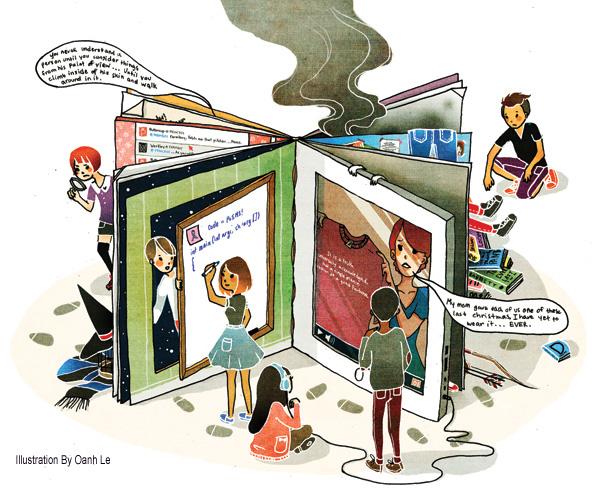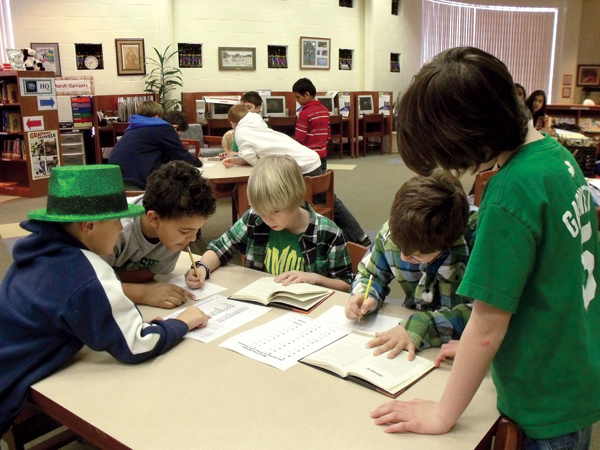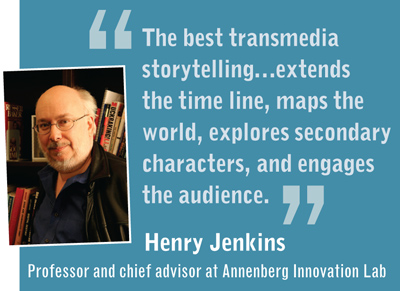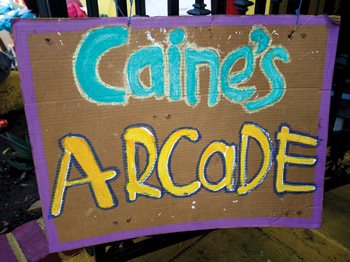 For one language arts class project, a middle school teacher in Shelburne, Virginia, Chad Sansing, asks his sixth graders to read Peter Cherches’s 1986 poem “Lift Your Right Arm,” and then translate it into computer code. The poem occurs in action sequences—for example, “Lift your right arm, she said./I lifted my right arm.” Sansing and his class conceive a list of actions, sketch ideas of how to code them, using icons or letters, and then code the poem. In doing so, the students become producers of both a new language and way of seeing poetry.
For one language arts class project, a middle school teacher in Shelburne, Virginia, Chad Sansing, asks his sixth graders to read Peter Cherches’s 1986 poem “Lift Your Right Arm,” and then translate it into computer code. The poem occurs in action sequences—for example, “Lift your right arm, she said./I lifted my right arm.” Sansing and his class conceive a list of actions, sketch ideas of how to code them, using icons or letters, and then code the poem. In doing so, the students become producers of both a new language and way of seeing poetry.
Sansing’s students have also translated the poem’s code into Scratch, to create animation, and into LEGO Mindstorms EV3, a robot-programming language. This innovative way of engaging students with poetry is just one example of how educators are increasingly integrating transmedia techniques in their teaching and assessments.
What is the point of this activity? “To help kids see connections between grammar and code,” says Sansing who shares his lessons on his “Classroots” blog.
Transmedia, a broad descriptive word that literally translated means “across media” and encompasses many strategies that transverse industries, is generally regarded as the use of multiple media platforms to tell a story or story experience. Though the word “transmedia” is thought to have entertainment franchise origins, its adaptation for education purposes is both valuable and becoming more and more common. While teachers like Sansing are using coding and programming in their language arts instruction, others are taking advantage of increasingly sophisticated apps and interactive media for classroom use.
From Gift to Pat the Bunny
Prominent examples of transmedia for young adults include the related book and app Chopsticks by Jessica Anthony and Rodrigo Corral (Penguin, 2012), a mystery about star-crossed teenage lovers told primarily through images—letters, photographs, and texts—which readers can manipulate in the app version. For those who seek it, Chopsticks videos and music clips are available on YouTube. Another example is Andrea J. Buchanan’s Gift (Open Road Integrated Media, 2012), a multimedia young adult novel about Danielle, a high school sophomore with a secret power. It has features such as a soundtrack, illustrations, a companion Minecraft “build-your-own-world” application, and Danielle’s journal.

Absecon (NJ) School District’s book club
engages in activities from “39 Clues.”
Engaging in transmedia storytelling can mean reading books in Scholastic’s wildly popular “39 Clues” series, which have sold 22 million copies worldwide since the first one came out in 2008, and then playing an interactive “39 Clues” online game. For Abescon (NJ) school district’s library media specialist, Rose Hagar, working transmedia into her after-school book club means her middle schoolers expand on the book’s content. They engage in discovery, like reading about “stone rubbings,” which the kids had never heard of before the series, and then they do some rubbings themselves, using crayon and paper—or research the Catacombs in Paris, a setting in “39 Clues,” only to realize it is a real, not fictional, place.
For the youngest learners, a transmedia moment can mean manipulating an interactive version of Pat the Bunny (S. & S., 1940), produced by Random House for iOS in 2011 that offers a nonlinear, make-your-own-story approach to this classic tactile picture book.
Transmedia is often related to technology, but it does “not have to privilege new media technologies,” according to Becky Herr-Stephenson, Meryl Alper, and Erin Reilly in the report “T Is for Transmedia: Learning Through Transmedia Play” that focused on transmedia play among children ages 5 through 11 (Joan Ganz Cooney Center at Sesame Workshop, 2013).
Also, “it doesn’t have to be high tech or cost a lot of money” says Jeff Gomez, CEO and founder of Starlight Runner Entertainment, a creator and producer of transmedia franchises like Mattel’s Hot Wheels. “Teachers don’t have to have tablets and mobile phones [in the classroom],” says Gomez, who started his career as a teacher in New York City public schools. “The child can create a musical or illustrated version of the text story. The bottom line is that the student needs to be able to look at the world in different ways.”
The term “transmedia” was coined in 1991 by Marsha Kinder, a retired professor of cinema studies at the University of Southern California (USC). In Playing with Power in Movies, Television and Video Games: From Muppet Babies to Teenage Mutant Ninja Turtles (University of California, 1991), Kinder used the term “transmedia supersystems” to describe the powerful, cross-platform reaches of entertainment franchises such as “Teenage Mutant Ninja Turtles,” “Garfield,” and the “Muppet Babies.”
However, New Jersey’s New Milford Public Schools library media specialist Laura Fleming argues “the real roots of transmedia…lie in education, as teachers have long sought out diverse resources and strategies to reach and engage their students” in her report “Expanding Learning Opportunities with Transmedia Practices: Inanimate Alice as an Exemplar” (Journal of Media Literary Education, 2013).
Teaching “Inanimate Alice”
Fleming is known for her extensive teaching use of the interactive fictional Web series “Inanimate Alice,” written and directed by Kate Pullinger. The story, told over ten episodes, begins when eight-year-old Alice is living in a tent in China. After her father, an oil driller, goes missing, she and her mother go on a quest to find him. With a tense, pulse-quickening soundtrack, the story incorporates technologies that students relate to, such as smartphone games, Skype, and GPS. Advancing the plot requires viewers to click a mouse and occasionally interact with the story.
 While “Inanimate Alice” wasn’t created for educational purposes, the narrative lends itself to teaching, as Fleming has proven with her classwork. The story’s various locations provide an opportunity to explore geography and history. For her sixth graders, Fleming initially showed her students the first episode without sound and asked them to use T-charts to compare and contrast their ideas about who they think Alice is (and who she actually turns out to be), and predict what will happen. Fleming, who has been both a teacher and a librarian over the past 16 years, includes her lesson plan for her sixth graders on her “Promethean Planet” blog.
While “Inanimate Alice” wasn’t created for educational purposes, the narrative lends itself to teaching, as Fleming has proven with her classwork. The story’s various locations provide an opportunity to explore geography and history. For her sixth graders, Fleming initially showed her students the first episode without sound and asked them to use T-charts to compare and contrast their ideas about who they think Alice is (and who she actually turns out to be), and predict what will happen. Fleming, who has been both a teacher and a librarian over the past 16 years, includes her lesson plan for her sixth graders on her “Promethean Planet” blog.
One of the best things about “Inanimate Alice,” she says, is that the series has many transmedia opportunities—or “breadcrumbs,” as Fleming calls them—for students wishing to expand on classroom assignments to explore on the Web.
For example, there is an Alice Facebook page (http://on.fb.me/ScjxOa), and by Googling “Inanimate Alice” and “Vimeo” you’ll find that kids have re-created their own versions of “Inanimate Alice” as part of school projects and beyond school. An example is featured on Pullinger’s website.
Narrative productions from the Australian developer Slap Happy Larry also feature compelling stories that lend themselves to educational use. In particular, Midnight Feast (Lynley Stace, 2013), an interactive story (for the tablet) about a future world where food shortages are prevalent, allows users to rub the screen to reveal alternative realities and hidden props. The developers’ site includes links to middle grade lesson plans (http://bit.ly/1mPYdsU) with teaching prompts such as asking students to look at the image of the main character Asaf’s bedroom and then draw and describe their own.

Meryl Alper, co-author of “T Is for Transmedia,”
at USC Annenberg Innovation Lab.
Photo by Maggie Smith, 2012.
The “Flotsam Project” and other explorations
“The best transmedia storytelling serves four key functions. It extends the time line, maps the world, explores secondary characters, and engages the audience,” says Henry Jenkins, USC professor and author of Convergence Culture: Where Old and New Media Collide (New York University Pr., 2006). Jenkins cites “The Matrix” franchise as an example of successful commercial transmedia—with three live-action films, a series of animated shorts, comic books, and video games offering access to “The Matrix” universe in different ways.
Jenkins, who is a chief advisor at USC’s Annenberg Innovation Lab, a research think tank, helmed an assignment with media graduate students called the “Flotsam Project.” In it, his students pitched potential ways to build out the world of David Wiesner’s 2007 Caldecott-winning wordless picture book Flotsam (Clarion, 2006), about a boy who finds an underwater camera that has washed ashore. The camera is full of fantastical photographs after it has made its way through various hands over generations.
The project serves as one of the three case studies in exemplary transmedia play featured in “T Is for Transmedia.” The Flotsam team created a dynamic interactive prototype for the iPad, in which a child can take his or her photo and insert the image into the story itself. In addition, the group proposed collectible Explorer Cards, which the transmedia play report said would “elaborate on the book’s illustrations and related scientific concepts.”
Beyond this important example, the published transmedia offerings for young children are rich. They include the interactive publisher Nosy Crow’s array of fine fairy-tale adaptions for the iPad for younger children; the Jack and the Beanstalk app (2014) incorporates a map, architectural cross-sections, and a changeable ending. Moonbot Studios’ productions of William Joyce’s The Fantastic Flying Books of Mr. Morris Lessmore debuted as an animated film, before being adapted as an app, then a book (2012), and finally, an augmented reality app (apps and film from Moonbot) that functions in conjunction with the book. Another standout, also from Moonbot, is The Numberlys, a cinematic story app with alphabet-related activities (2012) later published as a book (2014, both S. & S.).

Flickr photo by ebbandflowphotograph (www.flickr.com/chickpokipsie)
“Caine’s Arcade” as transmedia play
A prominent example of transmedia play is “Caine’s Arcade,” an “elaborate DIY cardboard creation built by a nine-year-old arcade-obsessed boy named Caine Monroy,” according to Herr-Stephenson and her co-authors in “T Is for Transmedia.” Over a summer, Caine constructed a complex cardboard arcade in front of his father’s used auto parts store in Los Angeles, with thoughtful details, like a security system made out of calculators. Monroy and his arcade gained national attention after a Los Angeles filmmaker, Nirvan Mullick, who stopped by the store to pick a car handle, became Monroy’s first customer.
“For adults like me, Caine’s arcade brings you back to your childhood,” said Mullick in an August 2012 story on NBC News.
Mullick used social media sites including Facebook and Reddit to organize a flash mob to surprise Caine and created an 11-minute documentary chronicling Caine’s story. Since the film Caine’s Arcade posted on YouTube (and Vimeo) on April 9, 2012, it has had over four million views on YouTube alone.
Over the course of two years, Herr-Stephenson and her colleagues studied and teased out the successful characteristics of transmedia play, a kind of transmedia learning that Herr-Stephenson says is “a modality of early learning that involves playing, exploration, and experimentation.” In the report, she points to the features of valuable transmedia play: it is social (conversing with others who may be co-located or linked to media/technology); accessible (allowing users to jump in from various starting points); and replayable (encouraging people to revisit multiple times), among others. It can also promote new approaches to reading and learning engagement. “What makes [transmedia play] fun and what makes it valuable for learning tends to dovetail,” says Herr-Stephenson.
The film Caine’s Arcade has practical classroom and afterschool transmedia applications. Kids who watched the video began to post their own versions of cardboard arcades on Facebook and YouTube. Mullick raised more than $235,000 and started the nonprofit Imagine Foundation. The organization inspired transmedia offshoots such as the “Caine’s Arcade School Pilot Program” in Wiki Spaces and the “Global Cardboard Challenge,” where schools can use the short film as a launch pad for transmedia play in classes exploring math, engineering, and more using a variety of materials, including cardboard. Kids around the world—more than 91,000 global participants from 46 countries—can share their project pictures, videos, and stories using the hashtag #cardboardchallenge.
Educational transmedia, at its best, broadens access to students with various learning styles. “Writing…shouldn’t be left out or dropped, but it should be seen as equal to other modes of expression and learning in schools,” says Sansing. But those who may not excel at traditional text reading and writing can find other forms of processing and expression through transmedia. It’s also iterative, inspiring a next level of engagement—which is powerful for the learning process. “[With transmedia], you are opening the door to these larger worlds,” as Herr-Stephenson puts it. “If [kids] really like it, they will build on it.”



Great write-up! You’ve created a good resource here for anyone looking to explore this area.
I’d also add the rise in collaborative games and role-playing that use technology like http://seekersunlimited.com/ and this from us where the students play space executives
https://www.youtube.com/watch?v=1Q9vL6laric
Thanks, Robert. And for sharing your resources. I encourage others to share here, because I am sure there are many that I missed in the article.
I forgot to mention Michael Minadeo’s game United Colonies http://educade.org/lesson_plans/united-colonies-arg-module-1
This is such a very, very important article! Thank you so much for writing it and for sharing all these amazing resources. This quote really sums it up: “the real roots of transmedia…lie in education.” So true. So very true. Also, it can’t be restated enough: “transmedia” does not have to be only tech based. Thank you again!
A key shift in almost all of these cross-platform and multi-platform creations is away from a single author toward a true creative collaboration between people with complementary skills: writing, coding, art, audio, social media outreach, and even marketing all combined to tell a story in which a highly engaged audience becomes participatory co-creators. Storytelling is increasingly becoming a hyphenated, hybrid process that never ends and continuously reinvents.
In the classroom, that open-ended collaboration translates to opportunities for terrific communication and team building skills and for individuals to learn to work across disciplines—kids who are great at art or writing can mesh that skill with coding and vice versa, to give just one example.
If I may offer an update: The long awaited Inanimate Alice episode 5 is coming out soon (a troubled Alice at age 16) and episode 6 will launch next year (Alice at 19, with a leap to a 3D game-like experience).